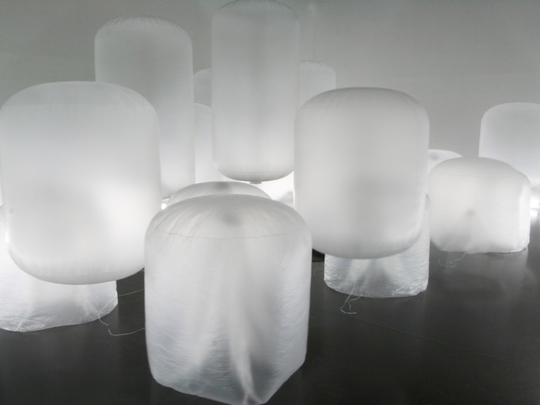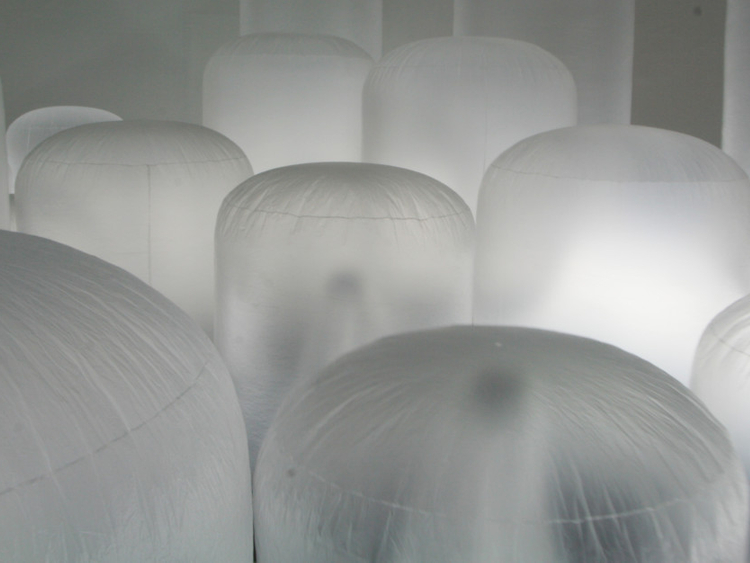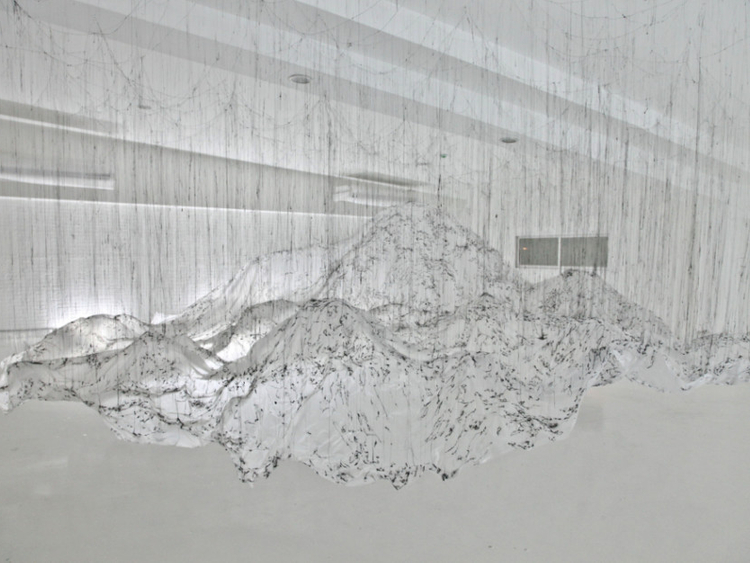
Rather than working with wood, metal or marble to create sculptures that occupy space, Japanese sculptor Yasuaki Onishi likes to use empty space as a material to create his sculptures. By using simple materials such as plastic sheeting and industrial hot glue, the artist creates works that transform the omnipresent but intangible element of space into a visible entity.
In previous works Onishi has used a unique technique for materialising negative space in his sculptures. He covers stacks of cardboard boxes with plastic sheeting held together with glue, and then removes the boxes leaving behind empty spaces that make the suspended sculptures look like amorphous floating clouds and mountain landscapes.
In his latest exhibition in Dubai, “Vertical Volume”, the artist has used plastic and industrial glue, along with invisible materials such as air, gravity and time to create a site-specific installation. The monumental installation, titled “Vertical Volume” is a collection of 14 thin cylindrical plastic bags suspended from the ceiling with fishing lines. Thanks to rotors connected with timers inside the bags, they gently expand and contract and move up and down the strings, almost as if they are living, breathing organisms.
“I am interested in visualising empty space by finding ways to materialise it. Here, the thin, almost transparent plastic cylinders fragment the space into discrete but ever-changing volumes. The plastic is like an imperceptible border between the air inside and outside; between the positive and negative space, and between ordinary space and art. As the bags change in shape and size the space inside them and the negative space around them become visible to us. While the machine inside them propels their upward movement along their own negative space, the downward movement is caused by gravity, thus creating a perceptible manifestation of time and gravity,” Onishi says.
The artist’s use of plastic sheeting can be seen as a comment on the layer of non-biodegradable plastic waste that is building up on the surface of our planet; and his floating cloud-like sculptures could be read as metaphors for modern communication technologies such as cloud computing, and our growing distance from reality as we lose ourselves in a virtual world.
Onishi is also presenting a new series of sculptural paintings, titled “Plates of Pressure”, which are made from hot glue. Here he used a glue gun to apply the glue in different patterns on to wood panels. The panels were then subjected to technical processes such as pressure bonding, industrial scratching, liquefaction by reheating, and polishing with aluminium and graphite powder, resulting in a variety of different patterns and textures on the surfaces. These visual traces of the processes speak about the material transformations taking place in our world ranging from the negative spaces created by mining to the pollution in the air, the garbage floating in the oceans and even in outer space.
“I like to use glue in my work because in its normal application it is not meant to be seen. Once again I want to transform the invisible glue used to bind things together, into something visible,” Onishi says.
The artist has also created an installation at hotel Vida Downtown Dubai, where he has used his cardboard box technique for “casting the invisible”. Working on scaffolding set up in the high-ceilinged lobby of the hotel, Onishi arranged a stack of cardboard boxes, which were covered with plastic sheeting held together with glue. The boxes were then removed, leaving behind an intricate yet monumental mountain-like structure that appears to be floating in space high above the hotel lobby. Viewers can experience the softly lit sculpture titled “Reverse Volume” by walking around it as well as from underneath.
Jyoti Kalsi is an arts-enthusiast based in Dubai.
“Vertical Volume” will run at The Mine, Al Quoz, until April 30. “Reverse Volume” will be on display at Vida Downtown Dubai until April 30.













